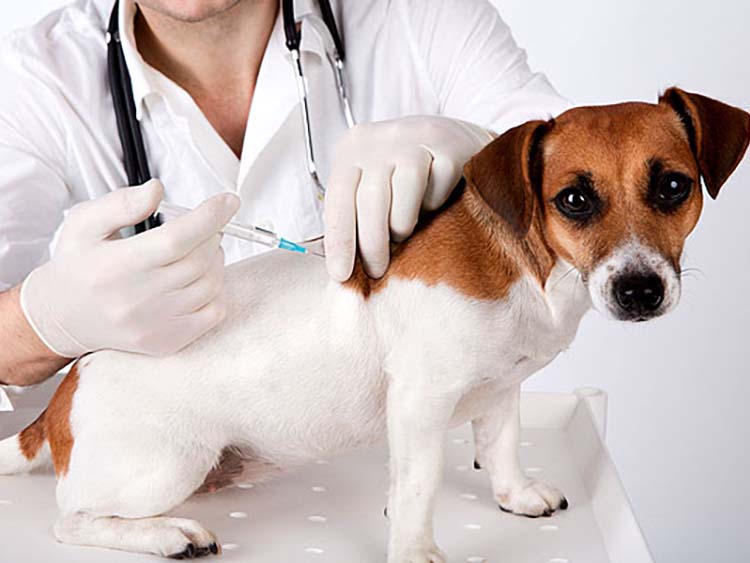
BEST FRIENDS ANIMAL RESCUE HEALTH & NUTRITION
Canine Vaccination Protocols
GLOBAL CANINE VACCINATION GUIDELINES
There are two sets of canine vaccination guidelines available: those produced by the American Animal Hospital Association [1] and those from the WSAVA VGG [2]. The fundamental principle of both sets of guidelines, as encapsulated by the VGG, is that ‘we should aim to vaccinate every animal with core vaccines and to vaccinate each individual less frequently by only giving non-core vaccines that are necessary for that animal’.
The WSAVA guidelines suggest that we should aim to vaccinate MORE animals. This relates to the phenomenon of ‘herd immunity’. Herd immunity suggests that where at least 75% of a herd of animals is vaccinated, it is difficult for an infectious disease outbreak to occur. The ‘herd’ for a small animal practitioner is the population of dogs living within his or her practice area – and our aim should be to have as many of these animals vaccinated as possible, in order to reduce the chances of disease outbreak in the herd. This is particularly important in the context of canine rabies. Where a mass vaccination campaign results in at least 70% of the dog population receiving vaccine, there is marked impact on the prevalence of canine and human rabies.
In order to apply the principles of vaccination guidelines, it is firstly necessary to understand the definitions of ‘core’ and ‘non-core’ vaccines. CORE vaccines are those that all animals should receive to protect them against diseases of global significance or where legislation may dictate [i.e. canine rabies]. The use of NON-CORE vaccines is dictated by geographical location, lifestyle and exposure risk. Some vaccines are NOT RECOMMENDED because there is little scientific justification for their use.
For dogs, the core vaccines are those that protect against canine distemper virus (CDV), canine adenovirus (CAV) and canine parvovirus-2 (CPV). In any country in which rabies is an endemic disease, then rabies vaccination is also considered core for dogs. Non-core canine vaccines include those that protect against leptospirosis, canine parainfluenza virus (CPi), Bordetella bronchiseptica and Borrelia. Canine coronavirus (CCV) vaccine is not recommended as there is little evidence that CCV is a primary enteric pathogen or that the vaccine can protect against such infection.
WSAVA guidelines provide generic advice to practitioners, but it is impossible to ensure that the guidelines are tailored to best fit the local situation in each of the 78 WSAVA member countries. The VGG encourages national associations to adapt and modify the guidelines for local use where appropriate. This process might involve altering the classification of a vaccine. For example, in the UK, Leptospira vaccine is considered core for the dog and attempts are now being made to provide data that define disease prevalence [3].
Core Vaccination of Puppies
The vaccination of puppies is determined by the transfer of maternally-derived antibody (MDA) from the bitch in colostrum. This antibody is crucial for protection of the pup during early life, but simultaneously blocks the endogenous immune response of the puppy to vaccination. Canine immunoglobulin has a half life of around 11 days and there is progressive decline in MDA concentrations in pups over the first weeks of life. The ‘window of susceptibility’ occurs when there is no longer sufficient maternal antibody to provide full protection from infectious disease, but where sufficient antibody remains to block the ability of the pup to make its own immune response to modified live virus (MLV) vaccine. Traditionally, this window has been taken to occur at between 8 – 10 weeks of age, but new evidence shows that higher titre vaccines increase maternal antibody concentrations leading to persistence of MDA for longer periods of time. Studies have now shown that around 1 in every 10 puppies has ‘blocking’ levels of MDA at 12 weeks of age. For this reason, vaccination guidelines now recommend that puppy vaccination (with MLV core vaccines) starts at 8 – 9 weeks of age, with a second vaccine 3 – 4 weeks later and a third vaccine given between 14 – 16 weeks of age (preferably at 16 weeks), to ensure that all pups have received at least one dose of vaccine in the absence of interfering MDA. A 12 month booster vaccine (either at 12 months of age or 12 months after the 16 week vaccine) is given to ensure full immunity develops. Where rabies is endemic, pups should receive 1 dose of vaccine at 12 weeks of age, but the VGG suggests that in a high-risk situation, a second dose of vaccine may be given 2 – 4 weeks later.
Core Vaccination of Adult Dogs
For adult dogs, MLV core vaccines should be given no more frequently than every 3 years. For CDV, CAV, CPV there is excellent correlation between the presence of serum antibody (virus neutralization test or haemagglutination inhibition test) and protection from challenge with infectious virus. There are extensive data showing that protective antibody persists in adult dogs, even when they have only been vaccinated as puppies up to 14 years previously [4, 5]. More importantly there are data that underpin the legal registration of canine core MLV vaccines for either 3 or 4 years, based on challenge studies that show that vaccinated dogs resist infection for that minimum period after vaccination (the minimum duration of immunity, DOI). Other experimental data show that dogs vaccinated as puppies only are protected from live virus challenge with CDV and CPV at 9 years of age [4]. On this basis, most of the internationally produced canine MLV core vaccines used in the USA, Europe and elsewhere now have a licensed minimum DOI of either 3 or 4 years.
This is also true for most of the internationally produced adjuvanted killed rabies vaccines that may legally be given every 3 years rather than annually. Where such products are available with a 3-year licensed DOI, but governmental legislation insists on annual rabies vaccination, it is beholden on the veterinary profession to lobby for changes to the law in order to prevent unnecessary revaccination of adult dogs. For example, in the USA, state laws changed gradually, such that now every US state stipulates triennial revaccination of dogs against rabies.
The ideal core revaccination schedule for adult dogs would therefore be revaccination every third year with CDV, CAV, CPV and rabies. Where rabies revaccination is still required annually, the schedule might be CDV, CAV and CPV triennially and rabies annually. Triennial revaccination reduces the number of unnecessary vaccines given to adult dogs and therefore reduces the changes of adverse reactions.
Non-core Vaccination
Non-core vaccines should be selected for the individual dog based on assessment of that particular animal’s risk of exposure to the disease and assessment of the benefits of vaccination to that pet versus the risk of adverse reaction. Decision making for non-core vaccines would be facilitated by having available good quality data and disease distribution maps related to small animal infectious diseases. Unfortunately, with the exception of rabies in the USA and Europe, such distribution maps are not widely available. Some national schemes have been developed by industry or academic groups which allow practitioners to input cases of particular infectious diseases into a database that presents the information as disease distribution maps.
Monitoring the distribution and evolution of infectious diseases is an important part of vaccinology. An excellent example is canine leptospirosis, which has recently attracted much research interest as the importance of particular serovars in causing canine disease in different geographical locations is determined. This new knowledge has led to the introduction of tetravalent canine leptospirosis vaccines in the US and Europe; the antigenic composition of which is related to the prevalence of serovars in each location. Similarly, in some countries (e.g. the USA and Korea) vaccines are available to protect against strains of canine influenza virus (CIV). This infection remains an issue for dogs that are intensively kenneled and transported (e.g. racing greyhounds), but the CIV vaccine would not be recommended for general use among pet dogs.
Non-core vaccines may be included into the puppy vaccination schedule if dictated by risk assessment. Intranasal vaccines protecting against some elements of the canine infectious respiratory disease complex (i.e. CPi and Bordetella bronchiseptica) might be used as early as four weeks of age (the VGG currently also suggests a second vaccine given 4 weeks later). The VGG recommends that where Leptospira vaccines are used in puppies (particularly adjuvanted bacterins) that these be given after the MLV core vaccines (e.g. at 18 and 22 weeks of age).
A major difference between MLV core vaccines and all of the non-core vaccines is that noncore vaccines (where used) require annual boosters as their DOI is no greater than 12–18 months. Adult dogs given non-core vaccines must therefore receive these annually. In many situations therefore, adult dogs receive ‘annual revaccination’, but just with fewer components than might have been used in the past.
The Annual Health Check
All aspects of vaccination should fall under an annual health check programme that reduces the emphasis on vaccination as a reason for visiting the practice and considers holistically the overall health and wellbeing of the pet. A discussion about which vaccines (or serological tests) might be offered in any one year is just one part of the annual health check. The importance of vaccination can be reinforced by using the VGG fact sheets. Vaccination (or serology) should be appropriately invoiced so emphasis is placed on the professional consultation.
References
- Welborn LV, DeVries JG, Ford R et al. 2011 AAHA canine vaccination guidelines. J Am Anim Hosp Assoc. 2011. 47: 5.
- Day MJ, Horzinek M, Schultz RD. Guidelines for the vaccination of dogs and cats. J Small Anim Pract. 2010. 51: 338-56.
- Ball C, Dawson S, Williams N. Leptospira cases and vaccination habits within UK vetvisiting dogs. Vet Rec. 2014. 174: 278.
- Schultz RD, Thiel R, Mukhtar E et al. Age and long-term protective immunity in dogs and cats. J Comp Pathol. 2010. 142: S102-08.
- Mitchell SA, Zwinjnenberg RJ, Huang J et al. Duration of serological response to canine parvovirus-type 2, canine distemper virus, canine adenovirus type 1 and canine parainfluenza virus in client-owned dogs in Australia. Aust Vet J. 2012. 90: 468-73.
BEST FRIENDS ANIMAL RESCUE HEALTH & NUTRITION








